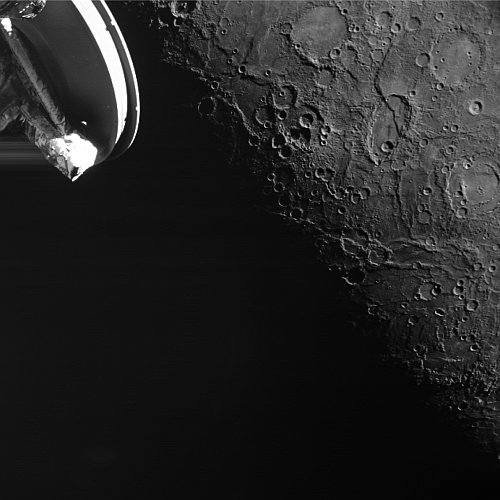BepiColumbo completes third Mercury flyby
On June 19, 2023, the European Mercury orbiter BepiColumbo made the third of six planned flybys of Mercury on its way to orbit around that planet in 2025.
The closest approach was only 146 miles above the planet’s surface. Though no pictures were taken at that point because it was Mercury’s night side, as the spacecraft moved away it used one of its monitoring cameras, designed primarily to monitor the spacecraft itself, to look back at the planet. The picture to the right, cropped, reduced, and sharpened to post here, is one of the first taken. From its caption:
The image was taken at 19:49 UTC (21:49 CEST) by the Mercury Transfer Module’s monitoring camera 3, when the spacecraft was about 2536 km from the planet’s surface. Closest approach took place at 19:34 UT (21:34 CEST) on the night side of the planet at about 236 km altitude. The back of the Mercury Planetary Orbiter’s high-gain antenna and part of the spacecraft’s body is also visible in front of Mercury in this image.
Despite the dark nature of the image, several interesting geological features are seen in beautiful detail. Of particular interest is Beagle Rupes, a 600 km-long scarp that snakes over the surface. In this view it is seen cutting through a distinctive elongated crater named Sveinsdóttir, which likely got its shape from an impactor striking the surface at an angle.
The next flyby will occur on September 5, 2024.
On Christmas Eve 1968 three Americans became the first humans to visit another world. What they did to celebrate was unexpected and profound, and will be remembered throughout all human history. Genesis: the Story of Apollo 8, Robert Zimmerman's classic history of humanity's first journey to another world, tells that story, and it is now available as both an ebook and an audiobook, both with a foreword by Valerie Anders and a new introduction by Robert Zimmerman.
The print edition can be purchased at Amazon or from any other book seller. If you want an autographed copy the price is $60 for the hardback and $45 for the paperback, plus $8 shipping for each. Go here for purchasing details. The ebook is available everywhere for $5.99 (before discount) at amazon, or direct from my ebook publisher, ebookit. If you buy it from ebookit you don't support the big tech companies and the author gets a bigger cut much sooner.
The audiobook is also available at all these vendors, and is also free with a 30-day trial membership to Audible.
"Not simply about one mission, [Genesis] is also the history of America's quest for the moon... Zimmerman has done a masterful job of tying disparate events together into a solid account of one of America's greatest human triumphs."--San Antonio Express-News
On June 19, 2023, the European Mercury orbiter BepiColumbo made the third of six planned flybys of Mercury on its way to orbit around that planet in 2025.
The closest approach was only 146 miles above the planet’s surface. Though no pictures were taken at that point because it was Mercury’s night side, as the spacecraft moved away it used one of its monitoring cameras, designed primarily to monitor the spacecraft itself, to look back at the planet. The picture to the right, cropped, reduced, and sharpened to post here, is one of the first taken. From its caption:
The image was taken at 19:49 UTC (21:49 CEST) by the Mercury Transfer Module’s monitoring camera 3, when the spacecraft was about 2536 km from the planet’s surface. Closest approach took place at 19:34 UT (21:34 CEST) on the night side of the planet at about 236 km altitude. The back of the Mercury Planetary Orbiter’s high-gain antenna and part of the spacecraft’s body is also visible in front of Mercury in this image.
Despite the dark nature of the image, several interesting geological features are seen in beautiful detail. Of particular interest is Beagle Rupes, a 600 km-long scarp that snakes over the surface. In this view it is seen cutting through a distinctive elongated crater named Sveinsdóttir, which likely got its shape from an impactor striking the surface at an angle.
The next flyby will occur on September 5, 2024.
On Christmas Eve 1968 three Americans became the first humans to visit another world. What they did to celebrate was unexpected and profound, and will be remembered throughout all human history. Genesis: the Story of Apollo 8, Robert Zimmerman's classic history of humanity's first journey to another world, tells that story, and it is now available as both an ebook and an audiobook, both with a foreword by Valerie Anders and a new introduction by Robert Zimmerman.
The print edition can be purchased at Amazon or from any other book seller. If you want an autographed copy the price is $60 for the hardback and $45 for the paperback, plus $8 shipping for each. Go here for purchasing details. The ebook is available everywhere for $5.99 (before discount) at amazon, or direct from my ebook publisher, ebookit. If you buy it from ebookit you don't support the big tech companies and the author gets a bigger cut much sooner.
The audiobook is also available at all these vendors, and is also free with a 30-day trial membership to Audible.
"Not simply about one mission, [Genesis] is also the history of America's quest for the moon... Zimmerman has done a masterful job of tying disparate events together into a solid account of one of America's greatest human triumphs."--San Antonio Express-News



I spent more than half my professional life teaching astronomy.
I spent almost as much time preparing tax returns for much more income.
Mercury has never been a particularly sexy planet. Lots of geology and volcanology, but we won’t be visiting there anytime soon very often.
I look at these photos and I see tax returns.